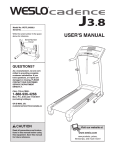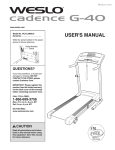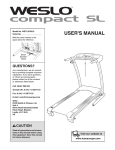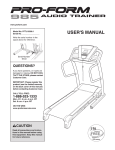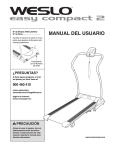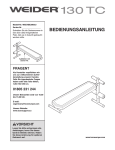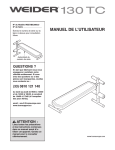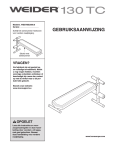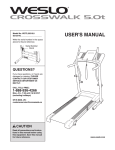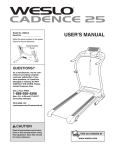Download Weslo WCTL29509.0 User`s manual
Transcript
Model No. WCTL29509.0 Serial No. Write the serial number in the space above for future reference. USER'S MANUAL Serial Number Decal QUESTIONS? If you have questions, or if parts are damaged or missing, PLEASE CONTACT OUR CUSTOMER SERVICE DEPARTMENT DIRECTLY. 1-888-936-4266 CALL TOLL-FREE: Mon.–Fri., 8:00 until 17:00 EST (excluding holidays) OR E-MAIL US: [email protected] CAUTION Read all precautions and instructions in this manual before using this equipment. Save this manual for future reference. www.weslo.com TABLE OF CONTENTS WARNING DECAL PLACEMENT . . . . . . . . . . . . . . . . . . . . . . . . . . . . . . . . . . . . . . . . . . . . . . . . . . . . . . . . . . . . . .2 IMPORTANT PRECAUTIONS . . . . . . . . . . . . . . . . . . . . . . . . . . . . . . . . . . . . . . . . . . . . . . . . . . . . . . . . . . . . . . . . .3 BEFORE YOU BEGIN . . . . . . . . . . . . . . . . . . . . . . . . . . . . . . . . . . . . . . . . . . . . . . . . . . . . . . . . . . . . . . . . . . . . . . .5 ASSEMBLY . . . . . . . . . . . . . . . . . . . . . . . . . . . . . . . . . . . . . . . . . . . . . . . . . . . . . . . . . . . . . . . . . . . . . . . . . . . . . . .6 OPERATION AND ADJUSTMENT . . . . . . . . . . . . . . . . . . . . . . . . . . . . . . . . . . . . . . . . . . . . . . . . . . . . . . . . . . . .12 HOW TO FOLD AND MOVE THE TREADMILL . . . . . . . . . . . . . . . . . . . . . . . . . . . . . . . . . . . . . . . . . . . . . . . . . .17 TROUBLESHOOTING . . . . . . . . . . . . . . . . . . . . . . . . . . . . . . . . . . . . . . . . . . . . . . . . . . . . . . . . . . . . . . . . . . . . . .19 EXERCISE GUIDELINES . . . . . . . . . . . . . . . . . . . . . . . . . . . . . . . . . . . . . . . . . . . . . . . . . . . . . . . . . . . . . . . . . . .21 PART LIST . . . . . . . . . . . . . . . . . . . . . . . . . . . . . . . . . . . . . . . . . . . . . . . . . . . . . . . . . . . . . . . . . . . . . . . . . . . . . . .23 EXPLODED DRAWING . . . . . . . . . . . . . . . . . . . . . . . . . . . . . . . . . . . . . . . . . . . . . . . . . . . . . . . . . . . . . . . . . . . . .24 ORDERING REPLACEMENT PARTS . . . . . . . . . . . . . . . . . . . . . . . . . . . . . . . . . . . . . . . . . . . . . . . . . .Back Cover LIMITED WARRANTY . . . . . . . . . . . . . . . . . . . . . . . . . . . . . . . . . . . . . . . . . . . . . . . . . . . . . . . . . . . . . . .Back Cover WARNING DECAL PLACEMENT This drawing shows the location(s) of the warning decal(s). If a decal is missing or illegible, see the front cover of this manual and request a free replacement decal. Apply the decal in the location shown. Note: The decal(s) may not be shown at actual size. WESLO is a registered trademark of ICON IP, Inc. 2 IMPORTANT PRECAUTIONS WARNING: To reduce the risk of serious injury, read all important precautions and instructions in this manual and all warnings on your treadmill before using your treadmill. ICON assumes no responsibility for personal injury or property damage sustained by or through the use of this product. 1. Before beginning this or any exercise program, consult your physician. This is especially important for persons over age 35 or persons with pre-existing health problems. or more amps. No other appliance should be on the same circuit. Do not use an extension cord. 12. To decrease the possibility of your treadmill being damaged, always use a surge suppressor with your treadmill. To purchase a surge suppressor call the telephone number on the front cover of this manual. 2. It is the responsibility of the owner to ensure that all users of this treadmill are adequately informed of all warnings and precautions. 3. Use the treadmill only as described. 13. Failure to use a properly functioning surge suppressor could result in damage to the control system of the treadmill. If the control system is damaged, the walking belt may slow, accelerate, or stop unexpectedly, which may result in a fall and serious injury. 4. Place the treadmill on a level surface, with at least 8 ft. (2.4 m) of clearance behind it and 2 ft. (0.6 m) on each side. Do not place the treadmill on any surface that blocks air openings. To protect the floor or carpet from damage, place a mat under the treadmill. 14. Keep the power cord and the surge suppressor away from heated surfaces. 5. Keep the treadmill indoors, away from moisture and dust. Do not put the treadmill in a garage or covered patio, or near water. 15. Never move the walking belt while the power is turned off. Do not operate the treadmill if the power cord or plug is damaged, or if the treadmill is not working properly. (See TROUBLESHOOTING on page 19 if the treadmill is not working properly.) 6. Do not operate the treadmill where aerosol products are used or where oxygen is being administered. 7. Keep children under age 12 and pets away from the treadmill at all times. 16. Read, understand, and test the emergency stop procedure before using the treadmill (see HOW TO TURN ON THE POWER on page 13). 8. The treadmill should not be used by persons weighing more than 250 lbs. (113 kg). 17. Never start the treadmill while you are standing on the walking belt. Always hold the handrails while using the treadmill. 9. Never allow more than one person on the treadmill at a time. 18. The pulse sensor is not a medical device. Various factors, including your movement, may affect the accuracy of heart rate readings. The pulse sensor is intended only as an exercise aid in determining heart rate trends in general. 10. Wear appropriate exercise clothes when using the treadmill. Do not wear loose clothes that could become caught in the treadmill. Athletic support clothes are recommended for both men and women. Always wear athletic shoes; never use the treadmill with bare feet, wearing only stockings, or in sandals. 19. The treadmill is capable of high speeds. Adjust the speed in small increments to avoid sudden jumps in speed. 11. When connecting the power cord (see page 12), plug the power cord into a surge suppressor (not included) and plug the surge suppressor into a grounded circuit capable of carrying 15 20. Never leave the treadmill unattended while it is running. Always remove the key and unplug the power cord when the treadmill is not in use. 3 21. Do not attempt to raise, lower, or move the treadmill until it is properly assembled. (See ASSEMBLY on page 6 and HOW TO FOLD AND MOVE THE TREADMILL on page 17.) You must be able to safely lift 45 lbs. (20 kg) to raise, lower, or move the treadmill. 25. Never drop or insert any object into any opening on the treadmill. 26. 22. When folding or moving the treadmill, make sure that the storage latch is holding the frame securely in the storage position. 23. Do not change the incline of the treadmill by placing objects under the treadmill. DANGER: Always unplug the power cord immediately after use, before cleaning the treadmill, and before performing the maintenance and adjustment procedures described in this manual. Never remove the motor hood unless instructed to do so by an authorized service representative. Servicing other than the procedures in this manual should be performed by an authorized service representative only. 27. This treadmill is intended for in-home use only. Do not use this treadmill in any commercial, rental, or institutional setting. 24. Inspect and properly tighten all parts of the treadmill regularly. SAVE THESE INSTRUCTIONS 4 BEFORE YOU BEGIN Thank you for selecting the new WESLO® CADENCE GTX treadmill. The CADENCE GTX treadmill combines advanced technology with innovative design to help you get the most from your exercise in the convenience of your home. And when youʼre not exercising, the treadmill can be folded up, requiring less than half the floor space of other treadmills. ing this manual, please see the front cover of this manual. To help us assist you, note the product model number and serial number before contacting us. The model number and the location of the serial number decal are shown on the front cover of this manual. Before reading further, please review the drawing below and familiarize yourself with the labeled parts. For your benefit, read this manual carefully before using the treadmill. If you have questions after readAccessory Tray Console Key/Clip Handrail Storage Latch Hood Walking Belt Reset/Off Circuit Breaker Power Cord Foot Rail Wheel Platform Cushion Idler Roller Adjustment Bolts 5 ASSEMBLY Assembly requires two persons. Set the treadmill in a cleared area and remove all packing materials; do not dispose of the packing materials until assembly is completed. G Note: The underside of the treadmill walking belt is coated with high-performance lubricant. During shipping, a small amount of lubricant may be transferred to the top of the walking belt or the shipping carton. This does not affect treadmill performance. If there is lubricant on top of the walking belt, simply wipe off the lubricant with a soft cloth and a mild, non-abrasive cleaner. In addition to the included hex keys , assembly requires a Phillips screwdriver , an adjustable wrench , and needlenose pliers . Use the drawings below to identify the hardware used during assembly. Note: If a part is not in the hardware kit, check to see if it has been preattached to one of the parts to be assembled. Extra hardware may be included. To avoid damaging plastic parts, do not use power tools for assembly. 16mm Screw (85)–2 M5 Star Washer (7)–2 M8 Star Washer (5)–6 18mm Screw (58)–2 M10 Flat Washer (14)–2 19mm Screw (10)–4 19mm Tek Screw (26)–6 M6 Flat Washer (32)–4 M8 x 52mm Bolt (82)–2 M6 x 58mm Bolt (13)–4 M8 Nut (46)–2 M8 Flat Washer (72)–4 M10 x 58mm Bolt (2)–4 M6 Nut (43)–4 M10 Star Washer (9)–2 M8 x 15mm Bolt (8)–6 M10 x 110mm Bolt (1)–2 1. Make sure that the power cord is unplugged. Place a piece of cardboard under the treadmill frame to protect the floor during assembly. 1 Have a second person hold the Base (52) in the position shown. Attach six Base Feet (63) to the Base (52) with six 19mm Tek Screws (26). 26 26 63 63 52 26 63 6 U 26 26 63 63 2. Have a second person hold the Base (52) in the position shown. 2 Identify the Left Upright (53) (the Right Upright [54] has a large hole near the lower end). Hold the Left Upright (53) so that the two indicated small holes are on top. Attach the Left Upright to the Base (52) with two M10 x 58mm Bolts (2). Do not tighten the Bolts yet. 54 Attach the Right Upright (54) to the Base (52) in the same way. Large Hole 2 52 Small Holes 2 53 3. Slide the two Wheel Housings (45) onto the Base (52). Attach each Wheel Housing with two M6 x 58mm Bolts (13), two M6 Flat Washers (32), and two M6 Nuts (43). 3 45 13 32 32 43 13 32 45 32 52 4. Remove the bolts (not shown) from the indicated holes in the Hood (65) (only one side is shown). Remove the cardboard packaging and discard the bolts. 4 Position the Base (52) as close to the front of the treadmill as possible. See the inset drawing. Locate the wire tie in the Right Upright (54). Tie the wire tie securely to the connector on the end of the Wire Harness (39). Next, pull the opposite end of the wire tie out of the upper end of the Right Upright, until the Wire Harness is routed completely through the Right Upright. Secure the Wire Harness to the upper end of the Right Upright so that it will not fall inside. 39 65 Wire Tie Hole 54 54 39 52 7 Wire Tie 43 5. See the left inset drawing and identify a Frame Spacer (11). Hold the Frame Spacer between the Right Upright (54) and the Frame (51). Attach the Right Upright to the Frame with an M10 x 110mm Bolt (1), an M10 Flat Washer (14), and an M10 Star Washer (9); do not fully tighten the Bolt yet. 5 54 9 11 51 11 54 14 11 6 1 53 1 14 9 11 51 11 1 53 14 9 8 1 9 51 6. Hold the other Frame Spacer (11) between the Left Upright (53) and the Frame (51). Attach the Left Upright to the Frame with an M10 x 110mm Bolt (1), an M10 Flat Washer (14), and an M10 Star Washer (9); do not fully tighten the Bolt yet. 14 11 51 7. Set the Console (91) face down on a soft surface to avoid scratching it. Next, identify the Right Handrail (33), which has a large hole in the location shown. Hold the Right Handrail near the Console. 7 Bracket Next, insert the console wire into the large hole in the side of the Right Handrail (33). Using needlenose pliers, carefully grasp the connector and pull the console wire out of the hole near the bracket on the Right Handrail. Connector Console Wire Large Hole 33 91 8. Set the Right Handrail (33) on the Console (91). Make sure that the console wire is not pinched. Start a 16mm Screw (85) with an M5 Star Washer (7) into the Right Handrail, and then start two 19mm Screws (10) into the Right Handrail. Tighten the 16mm Screw and then tighten the two 19mm Screws; do not overtighten the Screws. 8 Console Wire 85 7 10 33 Attach the Left Handrail (not shown) to the Console (91) in the same way. Note: There is not a console wire on the left side. 91 9 9. Have a second person hold the Console (91) near the Right Upright (54). Connect the Wire Harness (39) to the console wire. See the inset drawing. The connectors should slide together easily and snap into place. If they do not, turn one connector and try again. IF THE CONNECTORS ARE NOT CONNECTED PROPERLY, THE CONSOLE MAY BE DAMAGED WHEN THE POWER IS TURNED ON. Then, insert the connectors and the excess wire downward into the Right Upright (54). Remove the wire ties from the Wire Harness and the console wire. 10. Set the Console (91) on the Uprights (53, 54). Make sure that no wires are pinched. Start four M8 x 15mm Bolts (8) with four M8 Star Washers (5) into the Uprights as shown. Do not fully tighten the Bolts yet. 9 91 Console Wire 39 91 54 11. Start an M8 x 15mm Bolt (8) with an M8 Star Washer (5) into each Upright (53, 54). See steps 10 and 11. Firmly tighten all six M8 x 15mm Bolts. 39 54 10 Console Wire 5 8 8 5 53 11 With the help of a second person, carefully lower the Uprights (53, 54) to the floor. 8 5 8 53 8 8 5 10 54 12. Lower the Uprights (53, 54). See the lower drawing. Position the Uprights so that the treadmill Frame (51) is centered between the Uprights. 12 1 Firmly tighten the two M10 x 110mm Bolts (1) and the four M10 x 58mm Bolts (2). Be careful not to overtighten the M10 x 110mm Bolts. 51 Raise the Uprights (53, 54) to the vertical position. Top View 54 13. Attach the Latch Housing (48) to the Left Upright (53) with two 18mm Screws (58); start both Screws before tightening either of them. 2 53 51 13 53 48 58 14. Raise the treadmill to the storage position (see HOW TO FOLD THE TREADMILL FOR STORAGE on page 17). Attach an Incline Leg (95) to each side of the Frame (51) with an M8 x 52mm Bolt (82), two M8 Flat Washers (72), and an M8 Nut (46) as shown. Note: Do not overtighten the Nuts. The Incline Legs should be able to rotate easily. 14 82 72 72 95 Adjust the Incline Legs (95) to the desired incline (see page 16). 51 Lower the treadmill (see HOW TO LOWER THE TREADMILL FOR USE on page 18). 46 46 72 95 72 82 15. Make sure that all parts are properly tightened before you use the treadmill. Keep the included hex keys in a secure place. A hex key is used to adjust the walking belt (see page 20). To protect the floor or carpet, place a mat under the treadmill. 11 OPERATION AND ADJUSTMENT THE PRE-LUBRICATED WALKING BELT Your treadmill features a walking belt coated with highperformance lubricant. IMPORTANT: Never apply silicone spray or other substances to the walking belt or the walking platform. Such substances will deteriorate the walking belt and cause excessive wear. HOW TO PLUG IN THE POWER CORD DANGER: Improper connection of the equipment-grounding conductor can result in an increased risk of electric shock. Check with a qualified electrician or serviceman if you are in doubt as to whether the product is properly grounded. Do not modify the plug provided with the product—if it will not fit the outlet, have a proper outlet installed by a qualified electrician. tric shock. This product is equipped with a cord having an equipment-grounding conductor and a grounding plug. Plug the power cord into a surge suppressor, and plug the surge suppressor into an appropriate outlet that is properly installed and grounded in accordance with all local codes and ordinances. IMPORTANT: The treadmill is not compatible with GFCI-equipped outlets. This product is for use on a nominal 120-volt circuit, and has a grounding plug that looks like the plug illustrated in drawing 1 below. A temporary adapter that looks like the adapter illustrated in drawing 2 may be used to connect the surge suppressor to a 2-pole receptacle as shown in drawing 2 if a properly grounded outlet is not available. 1 This product must be grounded. If it should malfunction or break down, grounding provides a path of least resistance for electric current to reduce the risk of elec- Surge Suppressor Grounding Pin Your treadmill, like any other type of sophisticated electronic equipment, can be seriously damaged by sudden voltage changes in your homeʼs power. Voltage surges, spikes, and noise interference can result from weather conditions or from other appliances being turned on or off. To decrease the possibility of your treadmill being damaged, always use a surge suppressor with your treadmill (see drawing 1 at the right). To purchase a surge suppressor call the telephone number on the front cover of this manual Use only a single-outlet surge suppressor that is UL 1449 listed as a transient voltage surge suppressor (TVSS). The surge suppressor must have a UL suppressed voltage rating of 400 volts or less and a minimum surge dissipation of 450 joules. The surge suppressor must be electrically rated for 120 volts AC and 15 amps. There must be a monitoring light on the surge suppressor to indicate whether it is functioning properly. Failure to use a properly functioning surge suppressor could result in damage to the control system of the treadmill. If the control system is damaged, the walking belt may slow, accelerate or stop unexpectedly, which may result in a fall and serious injury. Grounded Outlet Box Grounding Pin 2 Grounded Outlet Grounding Plug Grounded Outlet Box Adapter Surge Suppressor Lug Metal Screw The temporary adapter should be used only until a properly grounded outlet (drawing 1) can be installed by a qualified electrician. The green-colored rigid ear, lug, or the like extending from the adapter must be connected to a permanent ground such as a properly grounded outlet box cover. Whenever the adapter is used it must be held in place by a metal screw. Some 2-pole receptacle outlet box covers are not grounded. Contact a qualified electrician to determine if the outlet box cover is grounded before using an adapter. 12 CONSOLE DIAGRAM Thumb Pulse Sensor Clip Key FEATURES OF THE CONSOLE HOW TO TURN ON THE POWER IMPORTANT: If the treadmill has been exposed to cold temperatures, allow it to warm to room temperature before turning on the power. If you do not do this, you may damage the console displays or other electrical components. The treadmill console offers a selection of features designed to make your workouts more effective. When you select the manual mode of the console, you can change the speed of the treadmill with the touch of a button. As you exercise, the displays will provide continuous exercise feedback. You can even measure your heart rate using the built-in pulse sensor. Plug in the power cord (see page 12). Next, locate the reset/off circuit breaker on the treadmill frame near the power cord. Make sure that the circuit breaker is in the “reset” position. The console also offers four speed programs. Each program automatically controls the speed of the treadmill as it guides you through an effective workout. IMPORTANT: If there is a sheet of clear plastic on the face of the console, remove the plastic. To prevent damage to the walking platform, wear clean athletic shoes while using the treadmill. The first time the treadmill is used, observe the alignment of the walking belt, and center the walking belt if necessary (see page 20). Reset Next, stand on the foot rails of the treadmill. Find the clip attached to the key (see the drawing above), and slide the clip onto the waistband of your clothes. Then, insert the key into the console. After a moment, the displays will light. IMPORTANT: In an emergency situation, the key can be pulled from the console, causing the walking belt to slow to a stop. Test the clip by carefully taking a few steps backward; if the key is not pulled from the console, adjust the position of the clip. 13 HOW TO USE THE MANUAL MODE The lower left display— As you exercise, the lower left display can show the elapsed time and the distance that you have walked or run. 1. Insert the key into the console. See HOW TO TURN ON THE POWER on page 13. 2. Select the manual mode. The lower right display—The lower right display can show the speed of the walking belt and the approximate number of calories that you have burned. The display also shows your heart rate when you use the pulse sensor (see step 5 on page 15). When the key is inserted, the manual mode will be selected. If you have selected a speed program, reselect the manual mode by pressing the Program Select button repeatedly until only zeros appear in the displays. 3. Start the walking belt. The upper display—The upper display can show the elapsed time, the distance that you have walked or run, the speed of the walking belt, or the approximate number of calories you have burned. Press the Display button repeatedly until the upper display shows the information that you are most interested in viewing. Note: While information is shown in the upper display, the same information will not be shown in the lower displays. To start the walking belt, press the Start button, the speed + button, or one of the numbered Quick Speed buttons. If you press the Start button or the speed + button, the walking belt will begin to move at 1 mph. As you exercise, change the speed of the walking belt as desired by pressing the speed + and – buttons. Each time you press a button, the speed setting will change by 0.1 mph; if you hold down a button, the speed setting will change in increments of 0.5 mph. Note: After you press the buttons, it may take a moment for the walking belt to reach the selected speed setting. To reset the displays, press the Stop button, remove the key, and then reinsert the key. The console can display speed and distance in either miles or kilometers. To see which unit of measurement is selected, first remove the key from the console. Next, hold down the Stop button, reinsert the key, wait until you hear a tone, and then release the Stop button. An “E” for English miles or an “M” for metric kilometers will appear in the upper display. Press the speed + button to change the unit of measurement if desired. When the desired unit of measurement is selected, remove the key and then reinsert it. If you press one of the numbered Quick Speed buttons, the walking belt will gradually change speed until it reaches the selected speed setting. To stop the walking belt, press the Stop button. The time will begin to flash in one of the displays. To restart the walking belt, press the Start button or the speed + button. 4. Follow your progress with the track and the displays. The track—The track represents a distance of 1/4 mile. As you walk or run on the treadmill, the indicators around the track will appear in succession until the entire track appears. The track will then disappear and the indicators will again begin to appear in succession. The center of the track will show the number of laps that you have completed. 14 5. Measure your heart rate if desired. Each program consists of 30 one-minute periods. One speed setting is programmed for each period. Note: The same speed setting may be programmed for two or more consecutive periods. The profiles printed on the console show how the speed of the walking belt will change during the programs. To measure your heart rate, stand on the foot rails and place your thumb on the pulse sensor (see the drawing on page 13). Do not press too hard, or the circulation in your thumb will be restricted and your pulse may not be detected. When your pulse is detected, the small heart symbol in the lower right display will flash, one or two dashes will appear, and then your heart rate will be shown. For the most accurate heart rate reading, hold your thumb on the pulse sensor for at least 15 seconds. 3. Press the Start button or the speed + button to start the program. When you press either button, the treadmill will automatically adjust to the speed setting that is programmed for the first period of the program. Hold the handrails and begin walking. If the displayed heart rate appears to be too high or too low, or if your heart rate is not displayed, lift your thumb for a few seconds, and then reposition your thumb on the pulse sensor. Remember to stand still while measuring your heart rate. When the first period ends, a series of tones will sound. If a different speed setting is programmed for the second period, the speed setting will flash in one of the displays to alert you, and then the speed of the walking belt will change. The program will continue until all 30 periods are completed. The walking belt will then slow to a stop. 6. When you are finished exercising, remove the key from the console. Step onto the foot rails, press the Stop button, remove the key from the console, and put it in a secure place. When you are finished using the treadmill, switch the reset/off circuit breaker to the “off” position and unplug the power cord. IMPORTANT: If you do not do this, the treadmillʼs electrical components may wear prematurely. If the speed setting is too high or too low during the program, you can manually override the setting by pressing the speed buttons. However, when the next period begins, the speed of the walking belt will change if a different speed setting is programmed for the next period. To stop the program, press the Stop button. The time will begin to flash in one of the displays. To restart the program, press the Start button or the speed + button. The walking belt will begin to move at 1 mph. When the next period begins, the speed of the walking belt will change if a different speed setting is programmed for the next period. HOW TO USE A SPEED PROGRAM 1. Insert the key into the console. See HOW TO TURN ON THE POWER on page 13. 2. Select one of the four speed programs. 4. Follow your progress with the track and the displays. To select a speed program, press the Program Select button repeatedly; “P- 1,” “P2,” “P- 3,” or “P- 4” will appear in the upper display for a few seconds to show which program is selected. The maximum speed setting of the selected program will also flash in one of the displays for a few seconds. See step 4 on page 14. 5. Measure your heart rate if desired. See step 5 on this page. 6. When you are finished exercising, remove the key from the console. See step 6 on this page. 15 HOW TO CHANGE THE INCLINE OF THE TREADMILL To vary the intensity of your exercise, you can change the incline of the treadmill. There are three incline levels. Before changing the incline, remove the key and unplug the power cord. Next, fold the treadmill to the storage position (see page 17). Incline Pin To change the incline, first remove the incline pin from one of the incline legs. Adjust the incline leg to the desired position, and then fully reinsert the incline pin. Adjust the other incline leg in the same way. CAUTION: Before using the treadmill, make sure that both incline legs are at the same height and that both incline pins are fully inserted into the incline legs. After you have adjusted the incline legs, lower the treadmill (see page 18). 16 Incline Legs Incline Pin HOW TO FOLD AND MOVE THE TREADMILL HOW TO FOLD THE TREADMILL FOR STORAGE Before folding the treadmill, remove the key and unplug the power cord. CAUTION: You must be able to safely lift 45 lbs. (20 kg) to raise, lower, or move the treadmill. 1. Hold the metal frame firmly in the location shown by the arrow at the right. CAUTION: To decrease the possibility of injury, do not lift the frame by the plastic foot rails. Make sure to bend your legs and keep your back straight. As you raise the frame, make sure to lift with your legs rather than your back. Raise the frame about halfway to the vertical position. Frame 2. Move your right hand to the position shown and hold the treadmill firmly. Using your left hand, pull the latch knob to the left and hold it. Raise the frame until the latch plate is past the latch pin. Then, slowly release the latch knob; make sure that the latch plate is resting against the latch pin. To protect the floor or carpet from damage, place a mat under the treadmill. Keep the treadmill out of direct sunlight. Do not leave the treadmill in the storage position in temperatures above 85° F (30° C). Latch Pin Latch Knob Latch Plate HOW TO MOVE THE TREADMILL Before moving the treadmill, convert the treadmill to the storage position as described above. Make sure that the latch plate is resting against the latch pin. 1. Hold the handrails and place one foot against one of the wheels. Do not pull back on the frame. 2. Tilt the treadmill backward until it rolls freely on the wheels, and carefully move the treadmill to the desired location. Never move the treadmill without tipping it backward. To reduce the risk of injury, use extreme caution while moving the treadmill. Do not attempt to move the treadmill over an uneven surface. 3. Place one foot against one of the wheels, and carefully lower the treadmill until it is in the storage position. 17 Handrail Wheel HOW TO LOWER THE TREADMILL FOR USE 1. Hold the upper end of the treadmill with your right hand as shown. Using your left hand, pull the latch knob to the left and hold it. Next, lower the frame until it is past the latch pin. Then, release the latch knob. Latch Pin Latch Knob 2. Hold the frame firmly with both hands, and lower it to the floor. To decrease the possibility of injury, bend your legs and keep your back straight. Frame 18 TROUBLESHOOTING Most treadmill problems can be solved by following the steps below. Find the symptom that applies, and follow the steps listed. If further assistance is needed, please see the front cover of this manual. PROBLEM: The power does not turn on SOLUTION: a. Make sure that the power cord is plugged into a surge suppressor, and that the surge suppressor is plugged into a properly grounded outlet (see page 12). Use only a single-outlet surge suppressor that meets all of the specifications described on page 12. IMPORTANT: The treadmill is not compatible with GFCI-equipped outlets. b. After the power cord has been plugged in, make sure that the key is inserted into the console. c. Check the reset/off circuit breaker located on the treadmill frame near the power cord. If the switch protrudes as shown, the circuit breaker has tripped. To reset the circuit breaker, wait for five minutes, and then press the switch back in. PROBLEM: The power turns off during use c Reset Tripped SOLUTION: a. Check the reset/off circuit breaker (see the drawing above). If the circuit breaker has tripped, wait for five minutes and then press the switch back in. b. Make sure that the power cord is plugged in. c. Remove the key from the console. Reinsert the key into the console. d. If the treadmill still will not run, please see the front cover of this manual. PROBLEM: The displays of the console do not function properly SOLUTION: a. Remove the key from the console and UNPLUG THE POWER CORD. Remove the three Hood Screws (20) and the two indicated Foot Rail Screws (25). Then, carefully remove the Hood (65). Locate the Reed Switch (89) and the Magnet (62) on the left side of the Pulley (71). Turn the Pulley until the Magnet is aligned with the Reed Switch. Make sure that the gap between the Magnet and the Reed Switch is about 1/8 in. (3 mm). If necessary, loosen the Reed Switch Screw (3), move the Reed Switch slightly, and then retighten the Screw. Reattach the Hood (not shown), and run the treadmill for a few minutes to check for a correct speed reading. 19 a 65 20 25 1/8 in. 3 89 Top View 62 71 PROBLEM: The walking belt slows when walked on SOLUTION: a. Use only a single-outlet surge suppressor that meets all of the specifications described on page 12. b. If the walking belt is overtightened, treadmill performance may decrease and the walking belt may become damaged. Remove the key and UNPLUG THE POWER CORD. Using the hex key, turn both idler roller bolts counterclockwise, 1/4 of a turn. When the walking belt is properly tightened, you should be able to lift each edge of the walking belt 2 to 3 in. (5 to 7 cm) off the walking platform. Be careful to keep the walking belt centered. Then, plug in the power cord, insert the key, and run the treadmill for a few minutes. Repeat until the walking belt is properly tightened. b 2–3 in. Idler Roller Bolts c. If the walking belt still slows when walked on, see the front cover of this manual. PROBLEM: The walking belt is off-center or slips when walked on SOLUTION: a. If the walking belt has shifted to the left, first remove the key and UNPLUG THE POWER CORD. Using the hex key, turn the left idler roller bolt clockwise 1/2 of a turn. Be careful not to overtighten the walking belt. If the walking belt has shifted to the right, turn the left idler roller bolt counterclockwise 1/2 of a turn. Then, plug in the power cord, insert the key, and run the treadmill for a few minutes. Repeat until the walking belt is centered. b. If the walking belt slips when walked on, first remove the key and UNPLUG THE POWER CORD. Using the hex key, turn both idler roller bolts clockwise, 1/4 of a turn. When the walking belt is correctly tightened, you should be able to lift each edge of the walking belt 2 to 3 in. (5 to 7 cm) off the walking platform. Be careful to keep the walking belt centered. Then, plug in the power cord, insert the key, and carefully walk on the treadmill for a few minutes. Repeat until the walking belt is properly tightened. 20 a b EXERCISE GUIDELINES WARNING: Burning Fat—To burn fat effectively, you must exercise at a low intensity level for a sustained period of time. During the first few minutes of exercise, your body uses carbohydrate calories for energy. Only after the first few minutes of exercise does your body begin to use stored fat calories for energy. If your goal is to burn fat, adjust the intensity of your exercise until your heart rate is near the lowest number in your training zone. For maximum fat burning, exercise with your heart rate near the middle number in your training zone. Before beginning any exercise program, consult your physician. This is especially important for persons over age 35 or persons with pre-existing health problems. The pulse sensor is not a medical device. Various factors may affect the accuracy of heart rate readings. The pulse sensor is intended only as an exercise aid in determining heart rate trends in general. Aerobic Exercise—If your goal is to strengthen your cardiovascular system, you must perform aerobic exercise, which is activity that requires large amounts of oxygen for prolonged periods of time. For aerobic exercise, adjust the intensity of your exercise until your heart rate is near the highest number in your training zone. These guidelines will help you to plan your exercise program. For detailed exercise information, obtain a reputable book or consult your physician. Remember, proper nutrition and adequate rest are essential for successful results. WORKOUT GUIDELINES EXERCISE INTENSITY Warming Up—Start with 5 to 10 minutes of stretching and light exercise. A warm-up increases your body temperature, heart rate, and circulation in preparation for exercise. Whether your goal is to burn fat or to strengthen your cardiovascular system, exercising at the proper intensity is the key to achieving results. You can use your heart rate as a guide to find the proper intensity level. The chart below shows recommended heart rates for fat burning and aerobic exercise. Training Zone Exercise—Exercise for 20 to 30 minutes with your heart rate in your training zone. (During the first few weeks of your exercise program, do not keep your heart rate in your training zone for longer than 20 minutes.) Breathe regularly and deeply as you exercise–never hold your breath. Cooling Down—Finish with 5 to 10 minutes of stretching. Stretching increases the flexibility of your muscles and helps to prevent post-exercise problems. EXERCISE FREQUENCY To find the proper intensity level, find your age at the bottom of the chart (ages are rounded off to the nearest ten years). The three numbers listed above your age define your “training zone.” The lowest number is the heart rate for fat burning, the middle number is the heart rate for maximum fat burning, and the highest number is the heart rate for aerobic exercise. To maintain or improve your condition, complete three workouts each week, with at least one day of rest between workouts. After a few months of regular exercise, you may complete up to five workouts each week, if desired. Remember, the key to success is to make exercise a regular and enjoyable part of your everyday life. 21 SUGGESTED STRETCHES The correct form for several basic stretches is shown at the right. Move slowly as you stretch—never bounce. 1. Toe Touch Stretch Stand with your knees bent slightly and slowly bend forward from your hips. Allow your back and shoulders to relax as you reach down toward your toes as far as possible. Hold for 15 counts, then relax. Repeat 3 times. Stretches: Hamstrings, back of knees and back. 1 2. Hamstring Stretch Sit with one leg extended. Bring the sole of the opposite foot toward you and rest it against the inner thigh of your extended leg. Reach toward your toes as far as possible. Hold for 15 counts, then relax. Repeat 3 times for each leg. Stretches: Hamstrings, lower back and groin. 2 3. Calf/Achilles Stretch With one leg in front of the other, reach forward and place your hands against a wall. Keep your back leg straight and your back foot flat on the floor. Bend your front leg, lean forward and move your hips toward the wall. Hold for 15 counts, then relax. Repeat 3 times for each leg. To cause further stretching of the achilles tendons, bend your back leg as well. Stretches: Calves, achilles tendons and ankles. 3 4 4. Quadriceps Stretch With one hand against a wall for balance, reach back and grasp one foot with your other hand. Bring your heel as close to your buttocks as possible. Hold for 15 counts, then relax. Repeat 3 times for each leg. Stretches: Quadriceps and hip muscles. 5. Inner Thigh Stretch Sit with the soles of your feet together and your knees outward. Pull your feet toward your groin area as far as possible. Hold for 15 counts, then relax. Repeat 3 times. Stretches: Quadriceps and hip muscles. 22 5 PART LIST—Model No. WCTL29509.0 Key No. Qty. 1 2 3 4 5 6 7 8 9 10 11 12 13 14 15 16 17 18 19 20 21 22 23 24 25 26 27 28 29 30 31 32 33 34 35 36 37 38 39 40 41 42 43 44 45 46 47 48 49 50 51 52 53 54 2 4 1 16 6 1 2 6 2 10 2 1 4 2 1 2 1 1 4 3 1 1 1 1 6 6 2 4 2 2 1 4 1 2 2 2 1 1 1 2 5 4 4 6 2 2 3 1 1 2 1 1 1 1 Description M10 x 110mm Bolt M10 x 58mm Bolt Reed Switch Screw M4.2 x 16mm Screw M8 Star Washer Warning Decal M5 Star Washer M8 x 15mm Bolt M10 Star Washer 19mm Screw Frame Spacer Console Back M6 x 58mm Bolt M10 Flat Washer Key/Clip M10 Nut 6 mm Hex Key 4 mm Hex Key Roller Bracket Screw/ Front Platform Screw Hood Screw M4.2 x 13mm Screw Left Handrail Upright Grommet Latch Pin Assembly Foot Rail Screw 19mm Tek Screw Walking Platform Bolt Belt Guide Screw Idler Roller Adj. Bolt Motor Bolt Motor Pivot Bolt M6 Flat Washer Right Handrail Motor Tension Bolt Wheel Bolt Idler Roller Star Washer Reset/Off Circuit Breaker Motor Star Washer Wire Harness Incline Pin Belly Pan Screw/Wire Tie Screw Electronics Star Washer M6 Nut Motor Tension Nut/Platform Nut Wheel Housing M8 Nut Hood Clip Latch Housing Belly Pan Grommet Isolator Fastener Frame Base Left Upright Right Upright Key No. Qty. 55 56 57 58 59 60 61 62 63 64 65 66 67 68 69 70 71 72 73 74 75 76 77 78 79 80 81 82 83 84 85 86 87 88 89 90 91 92 93 94 95 96 97 98 99 100 101 102 * * * * 1 1 1 2 1 1 1 1 6 1 1 1 1 1 4 2 1 4 1 2 4 1 4 2 1 2 4 2 1 8 2 1 1 1 1 1 1 1 2 1 2 2 1 2 1 2 1 2 – – – – Description R0609A Idler Roller Motor Belt Electronics Bracket 18mm Screw Motor Bracket Left Idler Roller Bracket Right Idler Roller Bracket Magnet Base Foot Latch Plate Hood Belly Pan Left Foot Rail Right Foot Rail Wheel Spacer Wheel Drive Roller/Pulley M8 Flat Washer Access Door Frame Cap Long Foot Rail Screw Walking Belt Handrail Cap Platform Cushion Drive Motor Wire Tie 8" Tie M8 x 52mm Bolt Reed Switch Clamp Controller Screw/Ground Screw 16mm Screw Walking Platform Controller Console Crossbar Reed Switch Power Cord Console Releasable Tie Belt Guide 5 mm Hex Key Incline Leg U-nut Drive Roller Washer Isolator Power Cord Grommet Cage Nut Motor Pivot Nut 1/4" Flat Washer 4" White Wire, MF 4" Blue Wire, 2F 4" Red Wire, M/F Userʼs Manual *These parts are not illustrated. Specifications are subject to change without notice. 23 29 36 24 44 40 95 72 60 82 74 102 84 42 27 75 98 4 19 6 50 46 72 25 29 55 102 78 36 74 84 42 75 10 67 44 25 27 93 95 19 46 61 72 4 64 25 72 51 68 40 82 86 28 44 25 25 19 98 76 83 41 62 89 4 71 3 78 96 97 56 101 19 10 31 28 50 25 41 96 17 94 93 44 41 21 18 41 EXPLODED DRAWING A—Model No. WCTL29509.0 R0609A EXPLODED DRAWING B—Model No. WCTL29509.0 20 20 47 47 30 34 38 59 47 65 44 84 84 42 42 84 34 79 66 84 81 20 84 57 37 99 49 92 25 87 90 R0609A EXPLODED DRAWING C—Model No. WCTL29509.0 77 88 10 7 77 10 85 22 100 8 58 24 5 35 69 70 69 33 5 10 7 8 8 77 100 85 39 41 9 11 32 63 2 32 43 16 69 70 69 26 13 43 26 11 63 26 63 26 4 80 54 53 13 16 10 5 52 45 10 8 48 14 43 43 10 5 1 32 77 10 10 R0609A 35 39 9 23 63 26 45 2 63 26 63 26 14 1 EXPLODED DRAWING D—Model No. WCTL29509.0 91 15 4 4 12 4 4 4 4 73 4 27 4 4 4 R0609A ORDERING REPLACEMENT PARTS To order replacement parts, please see the front cover of this manual. To help us assist you, be prepared to provide the following information when contacting us: • the model number and serial number of the product (see the front cover of this manual) • the name of the product (see the front cover of this manual) • the key number and description of the replacement part(s) (see the PART LIST and the EXPLODED DRAWING near the end of this manual) LIMITED WARRANTY ICON of Canada, Inc. (ICON) warrants this product to be free from defects in workmanship and material, under normal use and service conditions. The drive motor is warranted for one (1) year from the date of purchase. Parts and labor are warranted for ninety (90) days from the date of purchase. This warranty extends only to the original purchaser. ICONʼs obligation under this warranty is limited to repairing or replacing, at ICONʼs option, the product through one of its authorized service centers. All repairs for which warranty claims are made must be preauthorized by ICON. This warranty does not extend to any damage to a product caused by or attributable to freight damage, abuse, misuse, improper or abnormal usage, or repairs not provided by an ICON authorized service center; products used for commercial or rental purposes; or products used as store display models. No other warranty beyond that specifically set forth above is authorized by ICON. ICON is not responsible or liable for indirect, special, or consequential damages arising out of or in connection with the use or performance of the product; damages with respect to any economic loss, loss of property, loss of revenues or profits, loss of enjoyment or use, or costs of removal or installation; or other consequential damages of whatsoever nature. Some provinces do not allow the exclusion or limitation of incidental or consequential damages. Accordingly, the above limitation may not apply to you. The warranty extended hereunder is in lieu of any and all other warranties, and any implied warranties of merchantability or fitness for a particular purpose are limited in their scope and duration to the terms set forth herein. Some provinces do not allow limitations on how long an implied warranty lasts. Accordingly, the above limitation may not apply to you. This warranty gives you specific legal rights. You may also have other rights that vary from province to province. ICON of Canada, Inc., 900 de lʼIndustrie, St. Jérôme, QC J7Y 4B8 Part No. 283307 R0609A Printed in China © 2008 ICON IP, Inc.




























